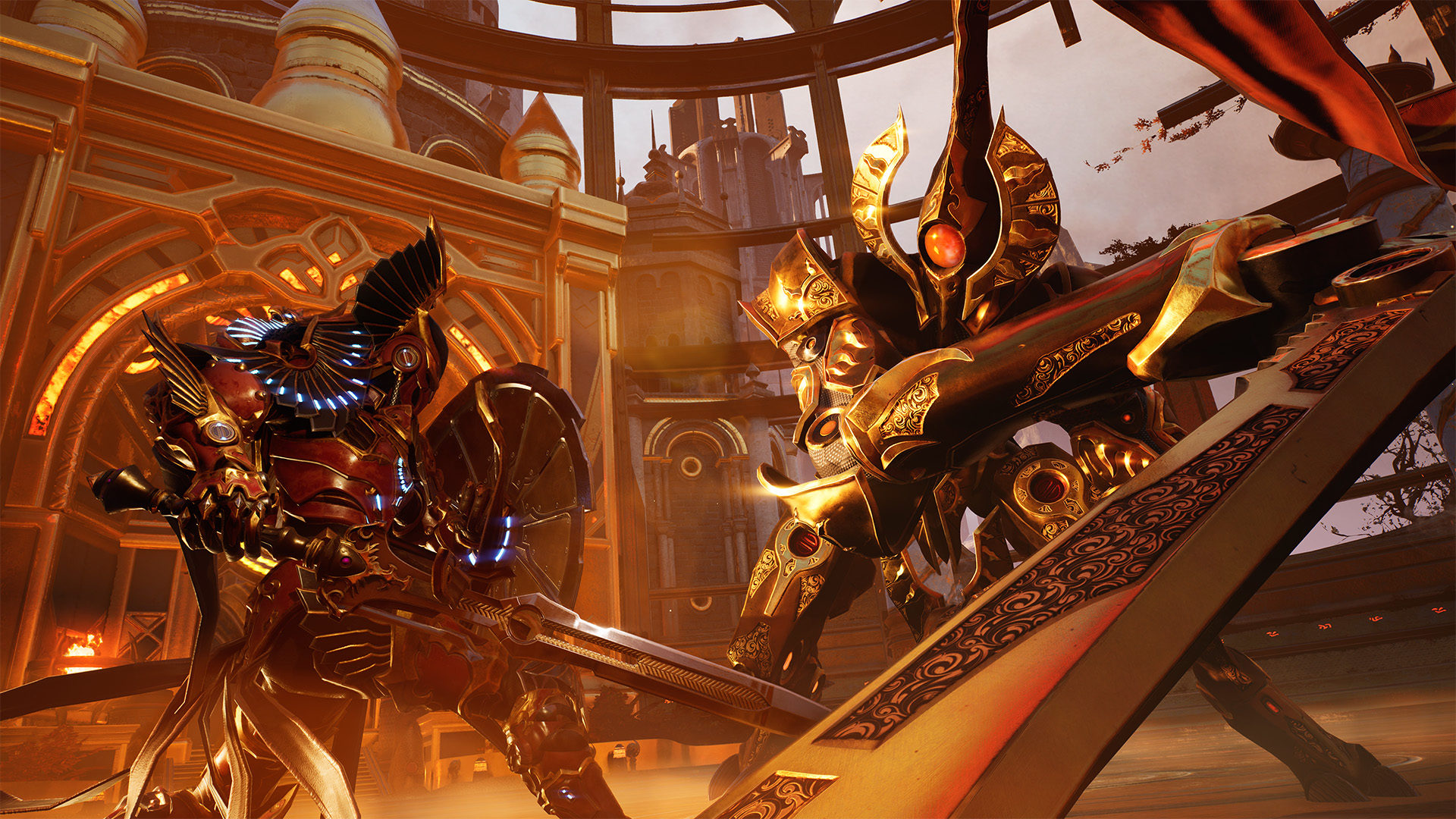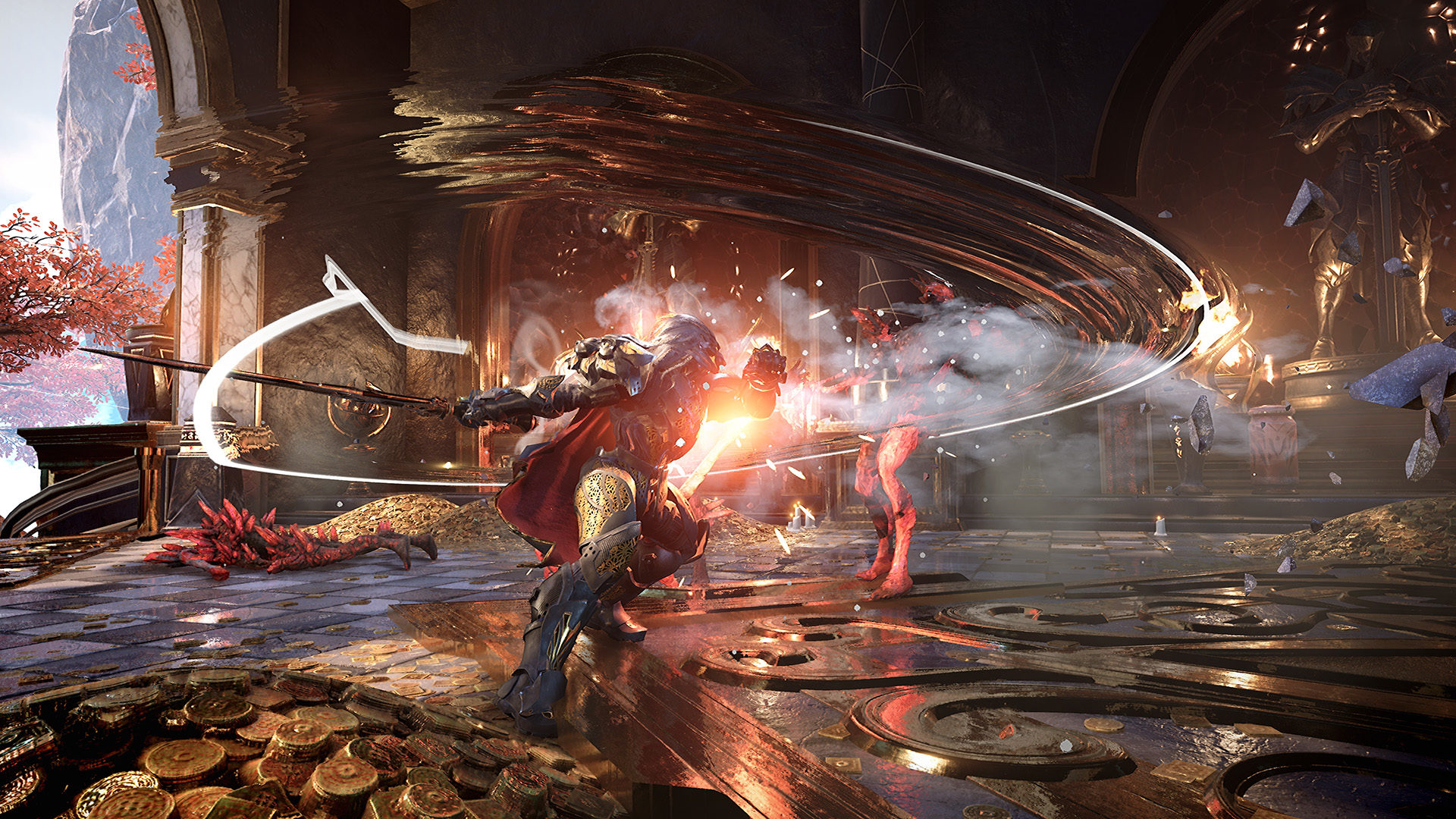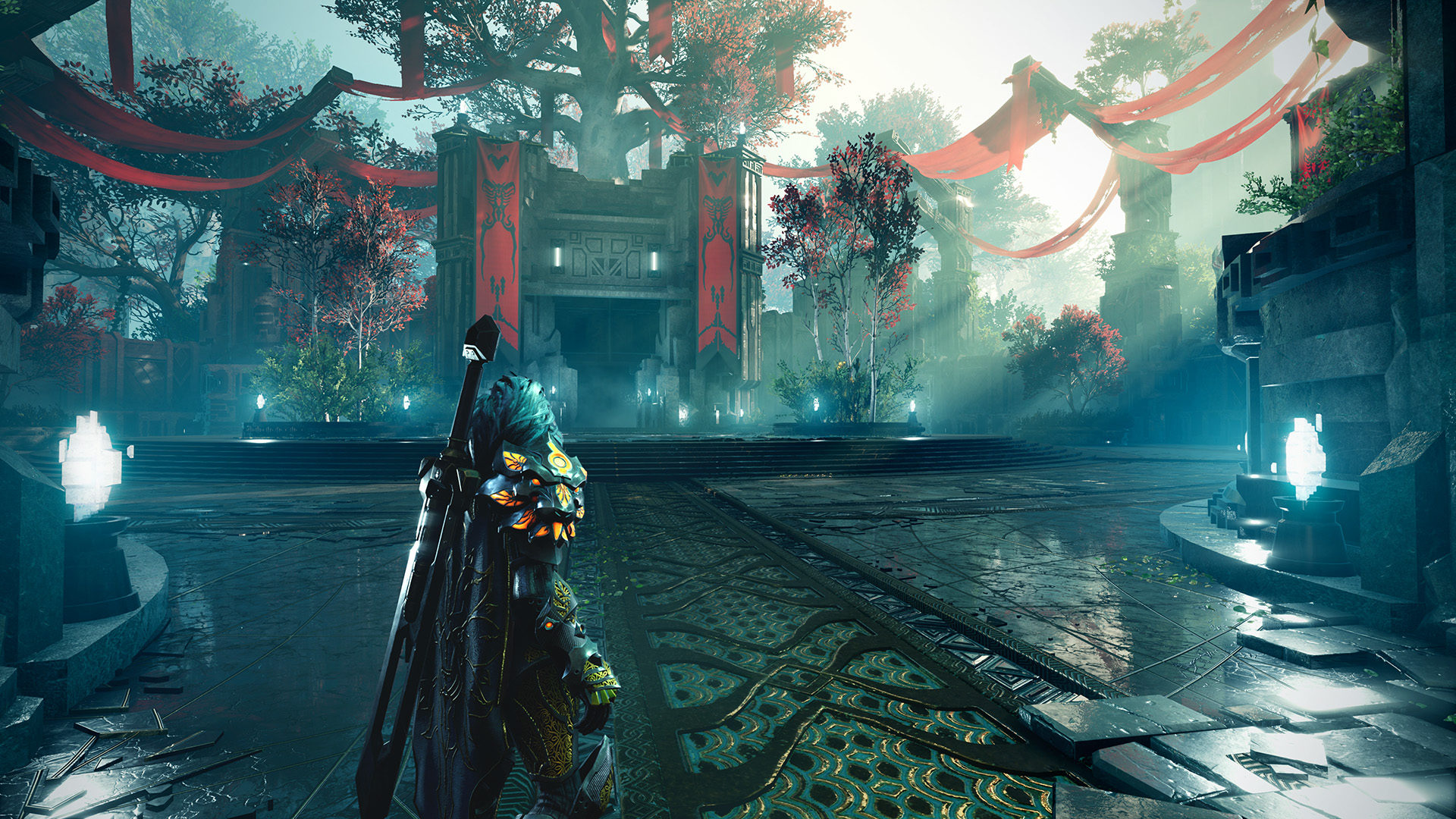Godfall’s greatest sin is that it mistakes complexity for quality. In seeking to build what it calls the first “looter-slasher,” the developers at Counterplay Games have layered intricate systems on top of intricate systems. But “more” doesn’t necessarily equal “more fun.”
Essentially all you need to know about Godfall‘s premise—at least judging by what it bothers to tell you—is that you, Orin, need to kill a dude in wolf-head armor named Macros. He’s trying to perform a ritual to become a god, but that ritual might fail and kill him and destroy the entire universe in the process. Also, he’s your brother.
Orin and Macros are Valorians, I think, but I’m not sure exactly what that means. By default, you have the voice of a man, but if you equip a different set of armor—called a Valorplate—you’ll get a woman’s voice. Even after beating the game, I’m totally unclear on how any of this works or what it means. Maybe you’re some kind of spirit being who brings the armor to life by inhabiting it?
Listen, I’m sure all of this is explained in the codex files you unlock while playing, at least to some degree. But if I can’t understand the fundamental rules of the world of a game just by playing it, not by reading on a menu, I feel like you’ve failed to actually tell a story.
Structurally, at least, the game is fairly straightforward. To defeat Macros, you need to take out his commanders, and to take them out you need to clear through missions in three different realms: Earth, Water, and Air.
You’ll select missions on a menu from a hub area, which is where you can also upgrade your gear and unlock new Valorplates. This is also where the game’s entire cast of allies—a whopping two—hang out. First is a floating head called the Seventh Sanctum who gives you your missions. Well, she’s actually three floating heads, but only one of them talks, so again, not really sure what’s going on. Second is a “godsmith” you recruit early on, who opens up your ability to upgrade gear and then just stands there. None of the characters, including Orin, have any defining traits or desires, beyond defeating Macros. Nothing really happens that you might call a plot. You just kill monsters, kill bosses, and then, eventually, kill Macros.

Of course, you can make a great game with a bad story, but neither half of Godfall’s “looter-slasher” formula delivers the way it should.
At the most basic level, the combat feels slow and unresponsive. You can’t interrupt your own attack animations to block or parry with the shield, or to heal yourself with your Life Stone, so your fingers and brain will frequently think you’ve taken the proper defensive action only for your eyes to discover that no, you actually haven’t. I’m sure some of this is an intentional design decision, to make it so that simply hammering inputs won’t get you very far. But if that’s the case, why would it extend to modifiers for the special attacks? If you’re in the middle of a combo and you hold down L2, the modifier for your so-called “weapon techniques,” you’re actually just going to continue with standard attacks unless you let the animations finish and wait a moment.
Beyond that, it’s painfully easy to just whiff on basic attacks. You actually need to aim the camera, and judge for yourself whether you’re close enough to your target, otherwise you’re liable to miss completely. There’s a reason most action games feature a soft-lock system that both aims (within reason) and closes the distance (within reason) to an enemy. The alternative, as evidenced by Godfall, is just frustrating.
But the truly bizarre thing isn’t that the fundamentals are so sluggish. It’s the number of convoluted modifiers you have at your disposal. If you hit an enemy with your quick attack, on R1, they’ll take damage but also mark a further section of their life bar. If you switch to a heavier R2 attack, it’ll wipe out the entire marked section of the life bar, as a kind of bonus damage called “Soulshatter.” This is a really neat idea, and if it were the focus of Godfall’s combat, I think the game could’ve done some interesting things with it.
Instead, there’s also a “break” bar you can build up to stun enemies, and polarity attacks that you can charge up by using one weapon and then unleash by swapping to another, and weak point attacks that require you to aim a targeting reticule at a glowing spot on the enemy before you attack, and a Rampage system that grants bonus damage for landing a lot of hits in a row, and timing attacks, and a banner you can drop into the arena to grant a buff for its duration, and shield throw attacks, and an Archon Fury attack that charges up during combat, and the aforementioned weapon techniques with their own separate meters. All this is on top of familiar combat elements like critical hits, status effects, and parries. It’s a lot. Maybe it wouldn’t be so conspicuous if all these systems flowed well together and the combat felt polished. But when I’m never really having fun in fights, the kitchen-sink design feels like an obvious culprit. Maybe Counterplay should’ve honed a few elements, rather than just piling on more.

The loot system suffers from a similar problem, but hardly to the same extent. Gear is split into eight main slots—two weapons, an amulet, a charm, two rings, a banner and a life stone. This all works fine, though there’s a noticeable lack of variety. Over the course of my playthrough, I only found a handful of gear items that had the potential to build around. Plus, I didn’t feel quality loot dropped frequently enough for me to be comfortable experimenting with different builds. The real complexity comes from the poorly explained “Augments” system, which has its own loot pool, its own slots, and a “power usage” system that caps what you can equip at once.
Maybe there’s a world where people want to min-max all of this stuff, and maybe there are high level players who can keep all of Godfall’s combat options in their head at once and truly master combat. But I’m not sure there’s much to master, really. In my experience, nearly every fight was so easy as to be brainless, except for three that were stupidly difficult. Even then, the absence of traditional checkpoints—when you die you just pick up where you left off, though bosses will regenerate back a portion of their health—means you can just slam your face into any fight until you eventually win. Importantly, this means you don’t need to actually learn what you’re doing wrong—if you’re even doing anything wrong.
And it’s not like the content surrounding the combat is engaging. Each of the three realms has its own overworld map, which is sectioned off for different missions. The problem is, all three maps manage to be somehow too corridor-like and too confusing at the same time. It’s like the level designers took a long piece of string, balled it up, and threw it on the ground, and that was the layout they went with. The absence of vantage points, landmarks, or any kind of in-game map mean it’s impossible to tell where you are at any given moment. If you’re just rushing through the story, that’s fine, since you’ll have a pretty smart dynamic waypoint keeping you on the path. But if you want to explore for hidden items and chests, you’re going to be going in circles a lot.
What’s more infuriating is that the game is designed with the assumption that you’ll try to explore. When you finish a mission, the game will keep you in the world and tell you that you can complete bonus challenges for additional loot drops. In fact, in nearly all instances, the game doesn’t even return you to the hub until you select “Complete Mission” from the pause menu, which is an insane design choice.

But if you stick around for those bonus objectives, you’ll soon discover a new frustration: The game doesn’t tell you where these additional challenges are located, forcing you instead to toggle on an alternate vision mode that causes collectibles and other special objects to glow. Even then, the levels are so dense that you can’t really see where you’re supposed to be headed over any horizon. The best you can get, usually, is a vaguely colored mist around corners that tells you which pathway might be the correct one. It’s just a lot of annoying wandering around, frequently in areas that don’t even have enemies to fight.
Honestly, by the time I approached the end of the story, I was rushing to finish—literally. Since the game doesn’t force you to fight regular enemies, you can usually just sprint past them to the objective. Given how much of the later content involved revisiting older areas and bosses to earn enough “sigils” to proceed to the next story missions, it was the only way for me to stay sane.
My gripes with Godfall are so plentiful that I’m almost 1,500 words in and I haven’t event mentioned the numerous technical issues I encountered:
- The frame rate hitches repeatedly, including pretty much every time you pick up an item. That’s true even in combat, and I died at least once because the action had stuttered.
- I encountered regular crashes back to the home screen.
- Once, the game managed to completely crash my PlayStation 5 to the point the system powered off.
- One of the high-tier gear items I picked up had a “+0%” damage bonus.
- I got stuck inside a chest and had to restart a mission after five minutes of trying to get out.
- In one challenge gauntlet, the enemy AI turned off completely, and I had to finish more than half of it by slaughtering enemies that spawned perfectly fine but then stood still until I killed them. Then, when I cleared the final level, the game wouldn’t register that I’d won, so I had to abandon the mission.
- Multiple times while playing, the game would stop registering one of my two attack types—I’d either be able to do R1 attacks just fine, or R2 attacks just fine, but the other button wouldn’t do anything.
We’re talking about constant issues—and this is a game that only took me 14 hours to beat.
I don’t know if Godfall was rushed out the door to meet the PlayStation 5’s launch, or if it didn’t get enough playtesting, or if Counterplay had to make the best of a project that wasn’t coming together the way it should have. Maybe I just had a stretch of extraordinarily bad luck.
But even if Godfall had run flawlessly on the PlayStation 5, I’d have a hard time recommending it to any early adopters. There’s the germ of an interesting game here, but for all the ambitions to start a new genre at the start of a new generation, Counterplay built something that plays more like a forgotten title from the PS2 era: overly complicated, cumbersome, and ignorant of so many of the design advancements of the past two generations.
All images: Counterplay Games, Gearbox Publishing
|
★★☆☆☆
Godfall’s sluggish, overly complicated combat, hilariously paper-thin story, and numerous technical issues make it a lowlight of the PlayStation 5’s launch lineup. |
Developer Counterplay Games Publisher Gearbox Publishing ESRB T - Teen Release Date 11.12.2020 |
| Godfall is available on PlayStation 5, PC. Primary version played was for PS5. Product was provided by Gearbox Publishing for the benefit of this coverage. EGM reviews on a scale of one to five stars. | |
